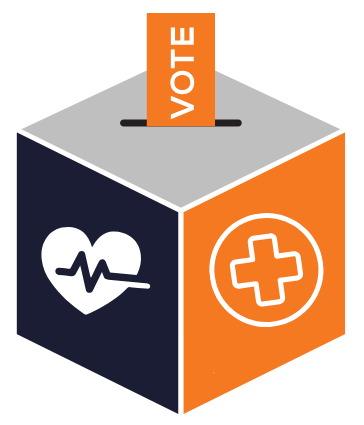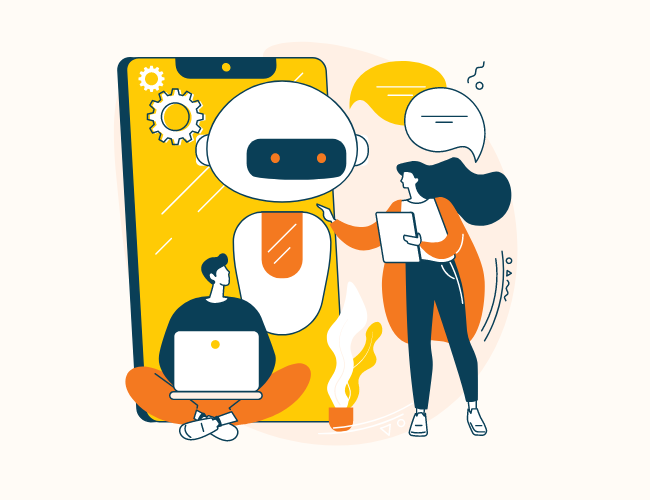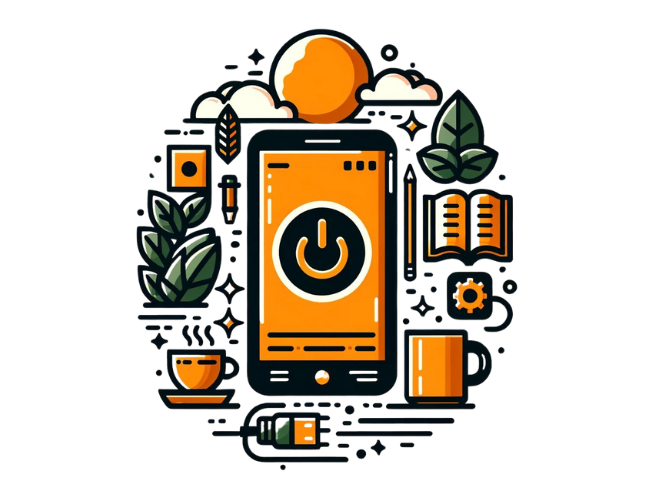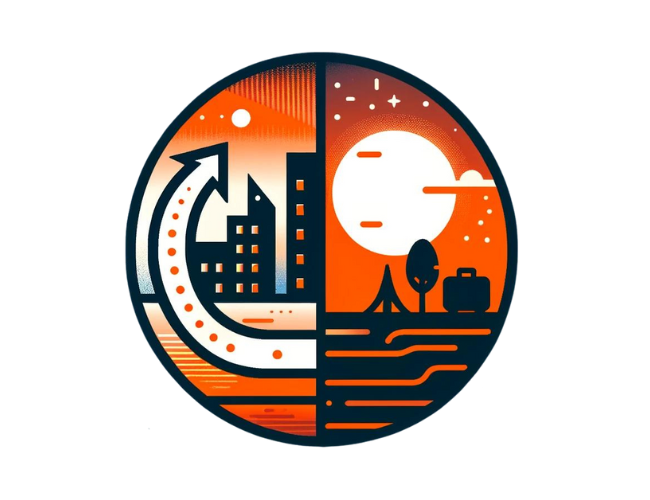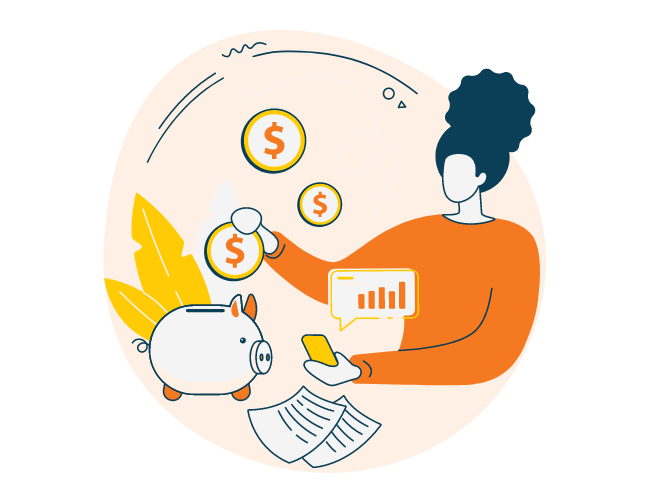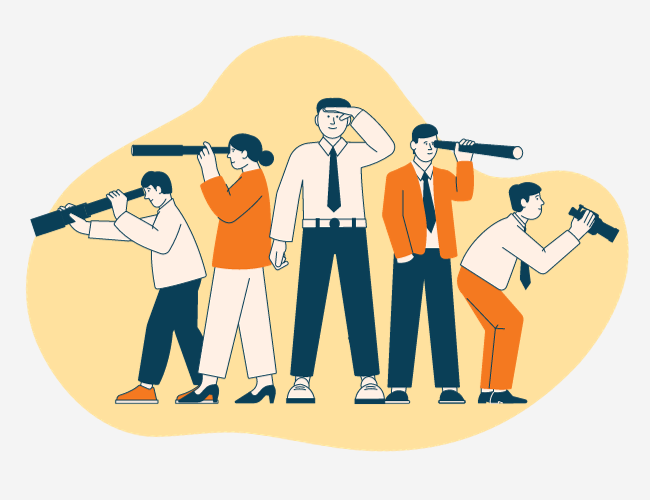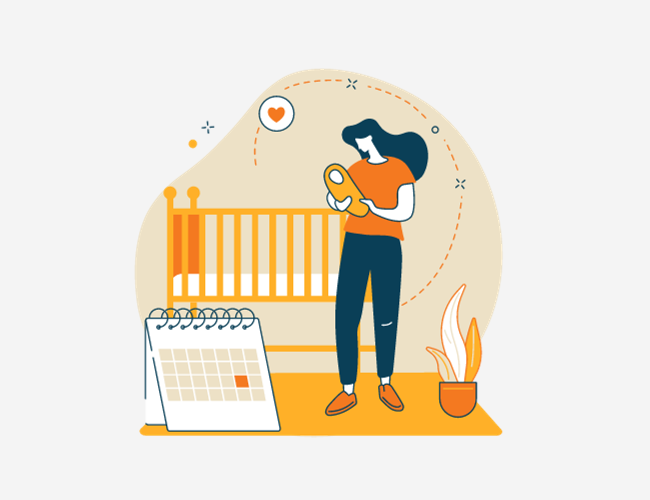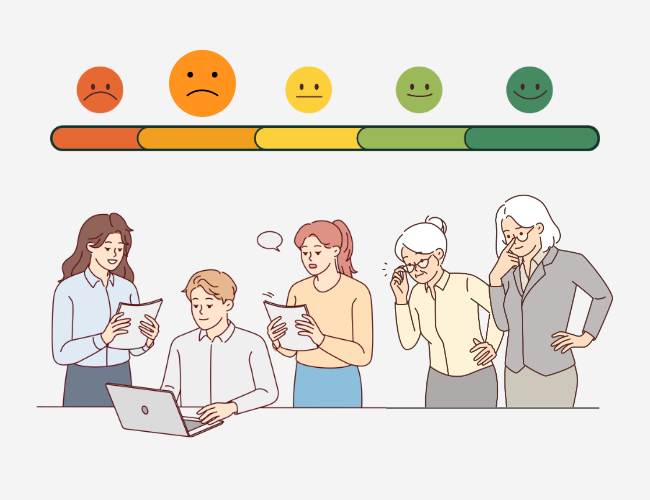ChatGPT and other forms of artificial intelligence (AI) are leading the charge toward a new era of work. Created by OpenAI, ChatGPT is a cutting-edge chatbot technology that uses natural language processing to yield “human-like” dialogue in response to user prompts. Its powerful capabilities could automate many business processes, capturing the attention of organizations everywhere.
This article covers examples of how ChatGPT can be applied in human resources, explains what it means for the future of HR, and outlines fundamental technological limitations that employees should be aware of.
Pressed for time? Here’s a quick summary…
- ChatGPT can streamline several human resources processes, from recruiting and onboarding to training and development, saving time and effort that can be devoted to higher-level tasks.
- The more specific the input, the better the output from ChatGPT.
- The best-case impact of ChatGPT on the future of work is that AI technologies will improve the quality and experience of work rather than replace employees.
- ChatGPT has inherent limitations that employees should be aware of, which can result in responses that are inaccurate, generic, or biased.
What Is ChatGPT?
ChatGPT is an advanced language model designed to understand and generate human-like text based on the input it receives. Powered by AI and machine learning, ChatGPT can carry conversations, draft content, answer questions, and assist with tasks. Its versatility makes it a valuable tool across industries and job functions—including in HR operations—where it can streamline workflows and automate routine tasks. By handling time-consuming processes, ChatGPT frees up time for professionals to focus on more strategic, value-driven initiatives.
ChatGPT And HR: Where ChatGPT Can Support
ChatGPT can streamline tasks and improve efficiency across several HR functions:
- Recruitment: ChatGPT helps HR leaders optimize recruitment operations and automate repetitive activities like generating follow-up emails and standard offer letters. This can improve candidates’ experiences and free up time for HR professionals to focus on strategic responsibilities.
- Hiring: It’s important to remember that talent acquisition is the beginning of relationship-building with employees, so maintaining human interaction is key in the hiring process. However, ChatGPT can enhance some manual work, like generating interview questions.
- Onboarding: A strong onboarding process sets new hires up for success. ChatGPT can create a more consistent experience for new employees, provide real-time guidance (e.g., instant answers to questions), and automate administrative tasks, such as scheduling meetings or sending reminders for forms to complete.
- Development: Training and development are essential to instill employee confidence and support professional growth. ChatGPT can assist in building training materials and offering personalized learning experiences.
- Performance: Effective performance management is key to driving employee growth and organizational success. With ChatGPT, HR professionals can draft comprehensive performance review outlines and support managers in setting realistic goals with their team members.
10 Examples Of How To Use ChatGPT In Human Resources
ChatGPT could change the game for human resources professionals. With an ever-growing need for efficiency in the workplace, businesses can use ChatGPT to streamline tasks, boost productivity, and improve the overall work experience.
1. Create Job Advertisements
A job posting is often a candidate’s first impression of a company and an open position. It sets expectations for the role and must be well-crafted to attract qualified individuals whose goals and experience align with the employer’s needs.
ChatGPT can help write compelling job advertisements that showcase the qualifications and responsibilities of a position. At a minimum, the input to ChatGPT should include the job title and what the company seeks in a candidate.
Sample input for inspiration: We are looking for a Marketing Manager who has at least one year of experience in the following areas: marketing strategy, social media, content creation, data analytics, project management, and leadership. Craft a job description highlighting the key responsibilities and qualifications for the role.
ChatGPT’s output:
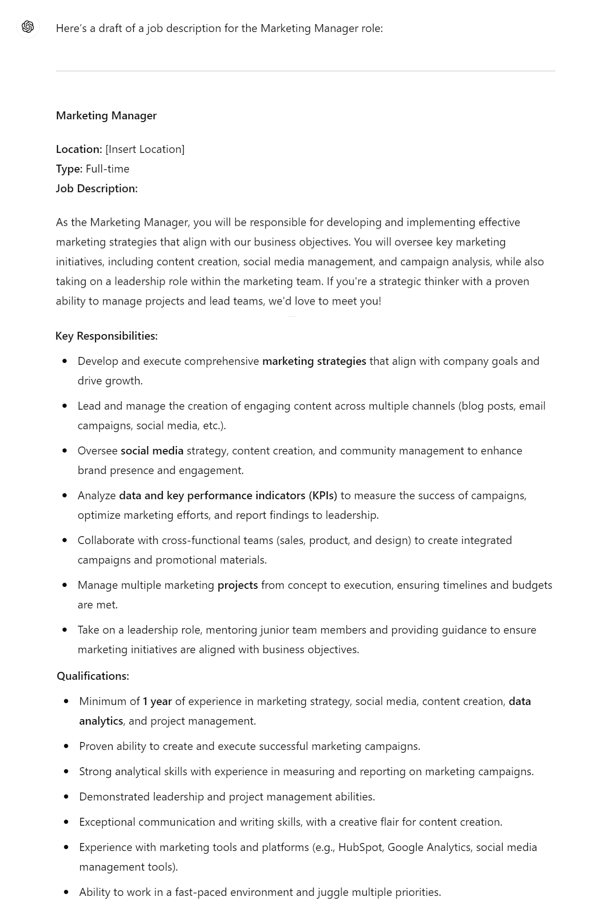
While ChatGPT quickly generates a well-written job advertisement, it might not align with the company’s precise needs, requirements, and brand. Alternatively, request a job posting template customized to the company’s specifications.
Sample input for inspiration: Create a job advertisement outline.
ChatGPT’s output:
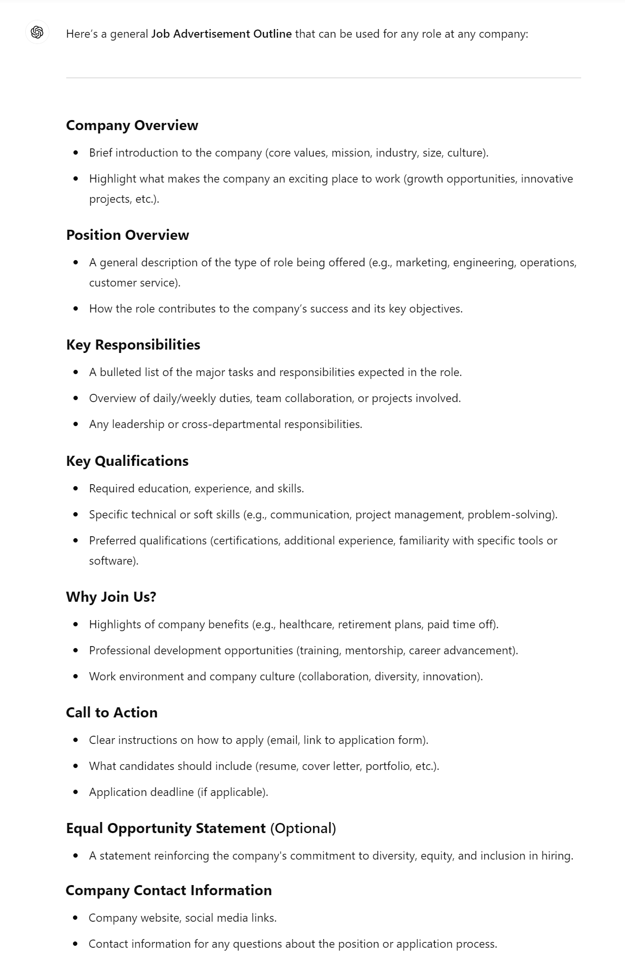
2. Generate Keywords For Job Descriptions
By including relevant keywords in a job posting, employers ensure their listing appears in the search results of job seekers who are most likely to be a good fit for the role. The input for ChatGPT should include a complete job description or general information about the position. Using “act like” prompts, such as “act like an expert in this field” or “act like a researcher,” can help ChatGPT produce more contextually appropriate responses.
Sample input for inspiration: Act like a researcher. Give me a list of keywords for a job description for a software engineer with a bachelor’s degree in computer science or engineering and at least three years of experience with Java.
ChatGPT’s output:
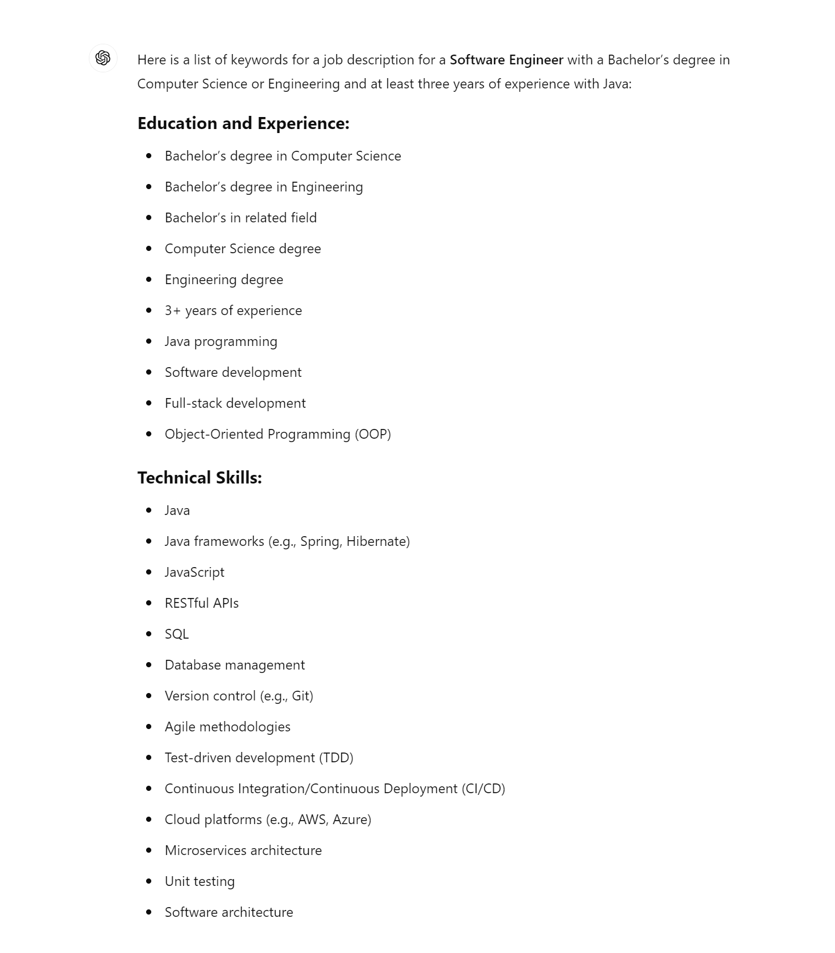
3. Produce Candidate Outreach Copy
For companies that are recruiting specific candidates, contacting them directly is an effective way to show interest. ChatGPT can write email copy for companies to send to potential candidates. The input should include information about the company and job role.
Sample input for inspiration: We are a fitness studio looking for personal trainers to join our team. Write a candidate outreach email to send to prospective candidates that will encourage them to apply.
ChatGPT’s output:
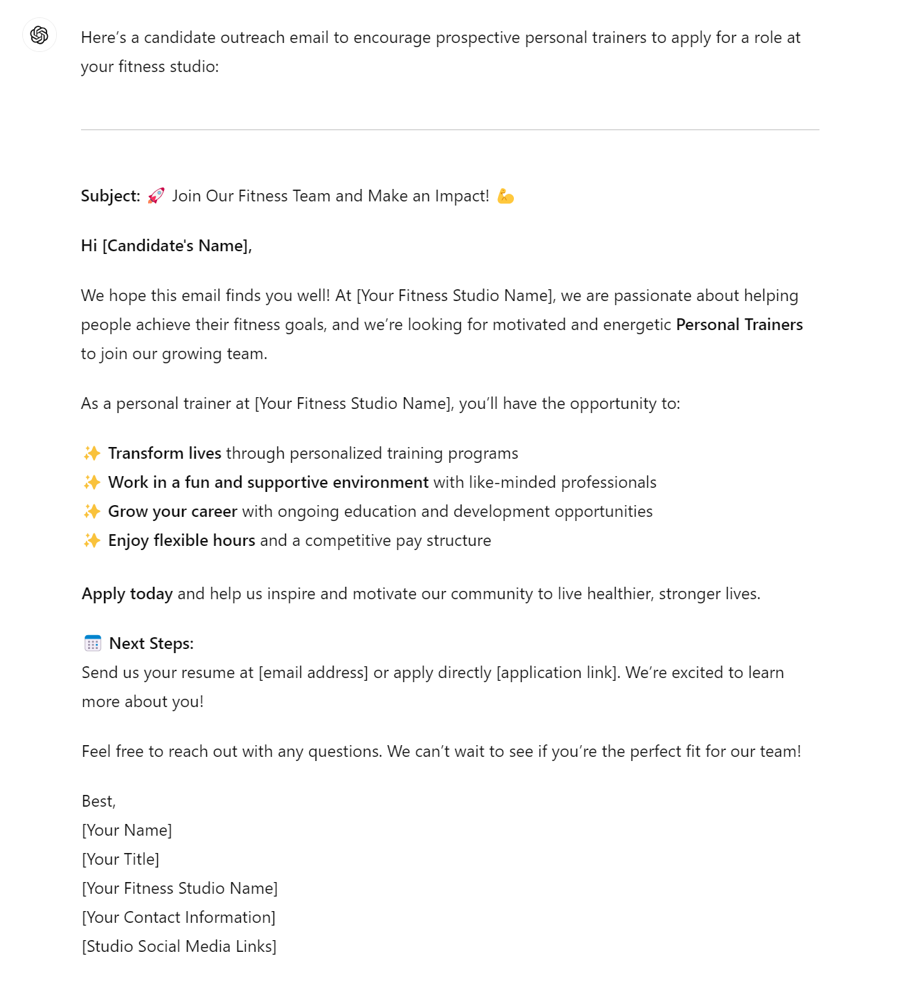
The more specific the prompt is, the better the output. Providing a completed job description or details about why the company is interested in a candidate produces a more relevant response. Using terms like “include” and specifying a tone further refines ChatGPT’s output.
Sample input for inspiration: Write an email for a potential candidate for a personal trainer role specializing in strength training and HIIT cardio for the fitness studio “FitX.” Begin with their experience in the fitness industry, then present the job opportunity. Include the benefits of working at FitX, like a free premium gym membership, a free family and friends membership, and competitive pay. Use a human-like and friendly tone.
ChatGPT’s output:
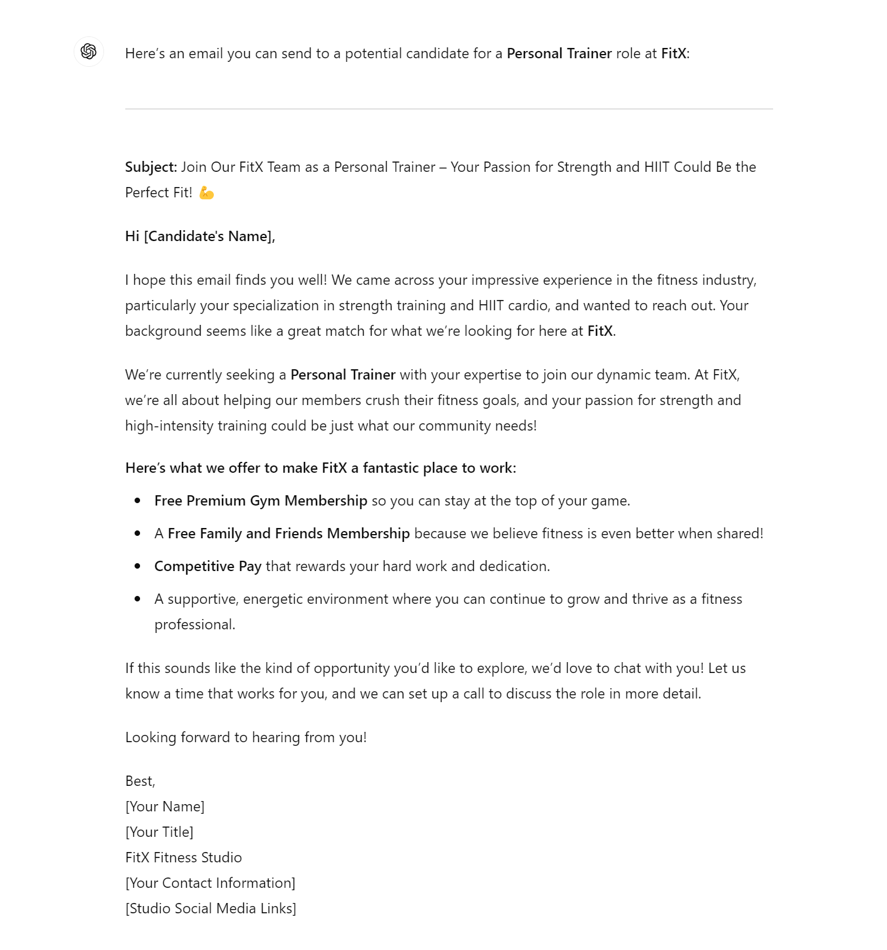
4. Draft Interview Questions
Beyond reviewing a resume or cover letter, interviews allow hiring managers to ask candidates questions that demonstrate their communication skills, problem-solving abilities, and work style. Preparing meaningful questions is critical to determine if the candidate is a good fit for the job, and ChatGPT can help brainstorm them. Requests can be modified for more specificity, such as asking for “20 behavioral questions” or “10 questions focusing on communication skills”.
Sample input for inspiration: I am interviewing with a potential candidate for a sales representative position. Generate 10 questions to evaluate the candidate’s experience, qualifications, and fit for the role. The candidate should have excellent communication and negotiation skills.
ChatGPT’s output:
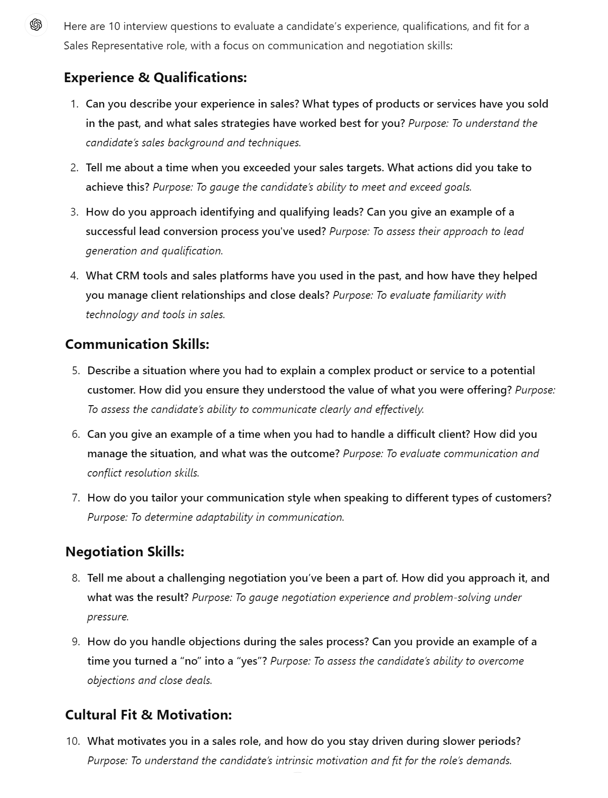
5. Write Hiring Requirements
By setting clear hiring requirements, companies avoid wasting time and resources on underqualified candidates. ChatGPT can assist in brainstorming hiring requirements for a role.
Sample input for inspiration: We want to hire an entry-level mechanical engineer for our construction firm. Create a brief list of key skills and qualifications we should look for in candidates.
ChatGPT’s output:
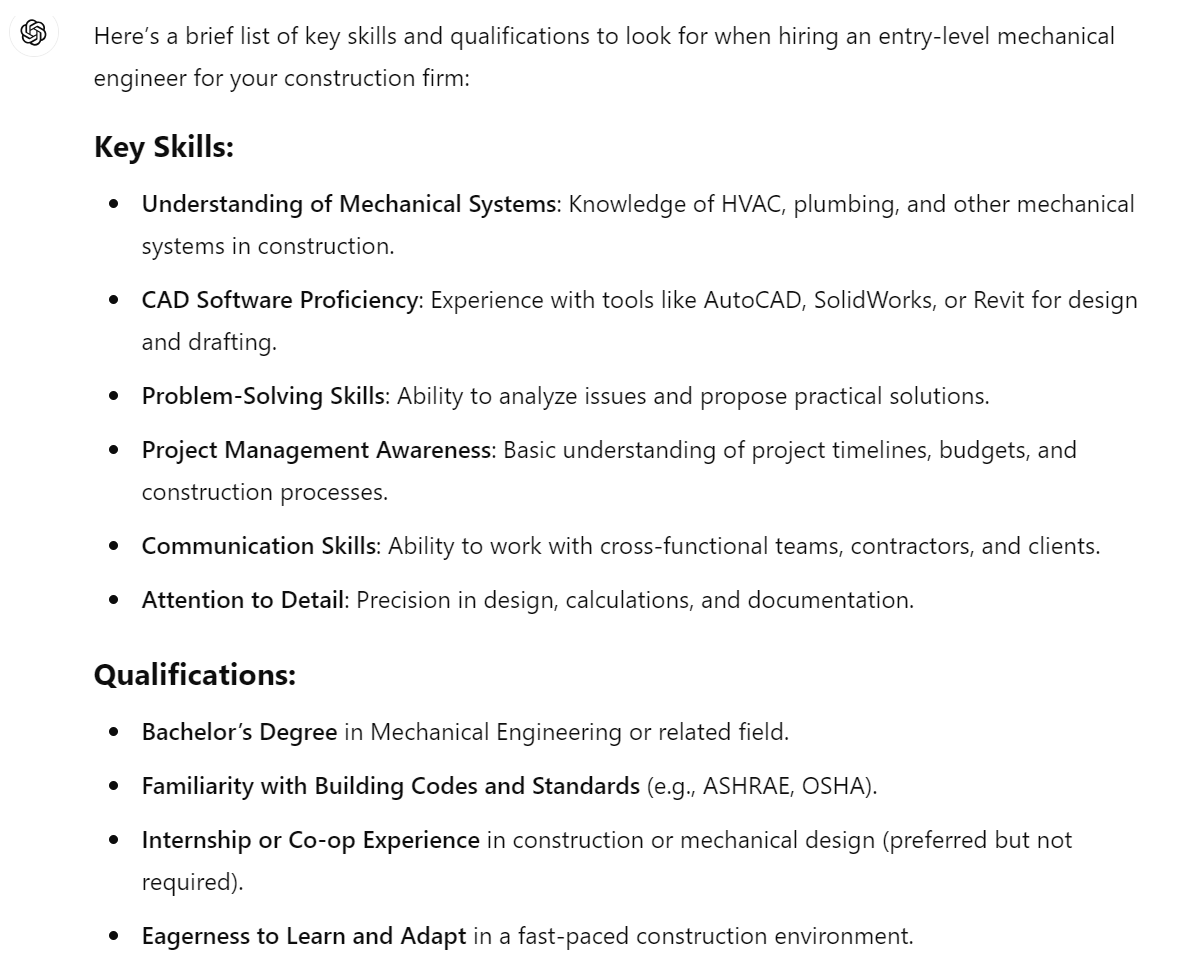
6. Create Company Policies
Company policies establish guidelines and expectations for employees to maintain a workplace that practices accountability, integrity, and safety. ChatGPT can help build policies that cover a wide range of topics, from employee conduct and dress code to benefits and time off procedures.
Sample input for inspiration: Our company is onboarding a medical scribe. Create onboarding materials that cover all the key policies and guidelines that our new hire will need to be familiar with, including employee benefits, time off policies, workplace safety, confidentiality agreements, and more.
ChatGPT’s output:
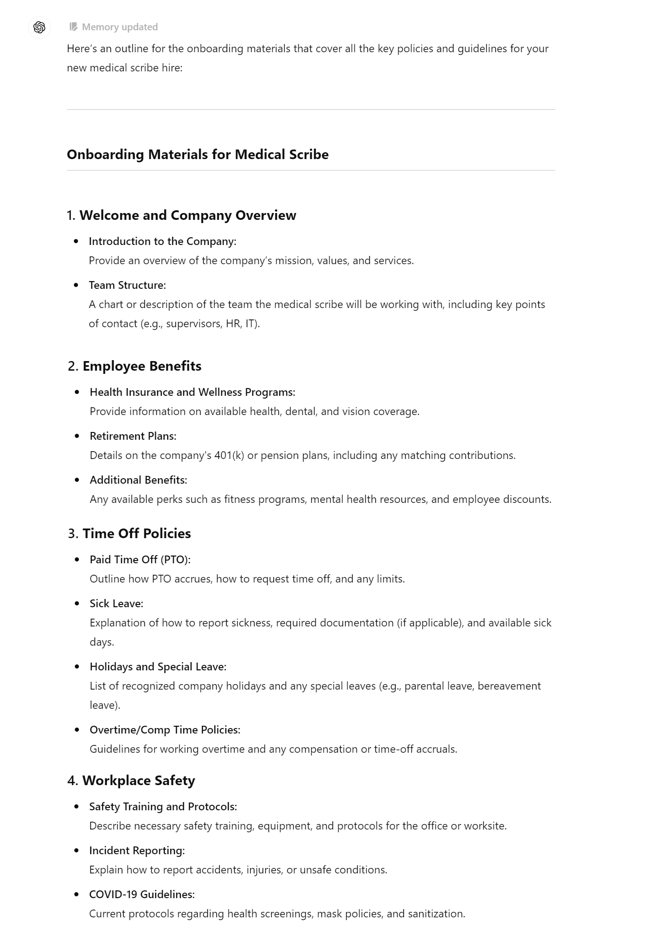
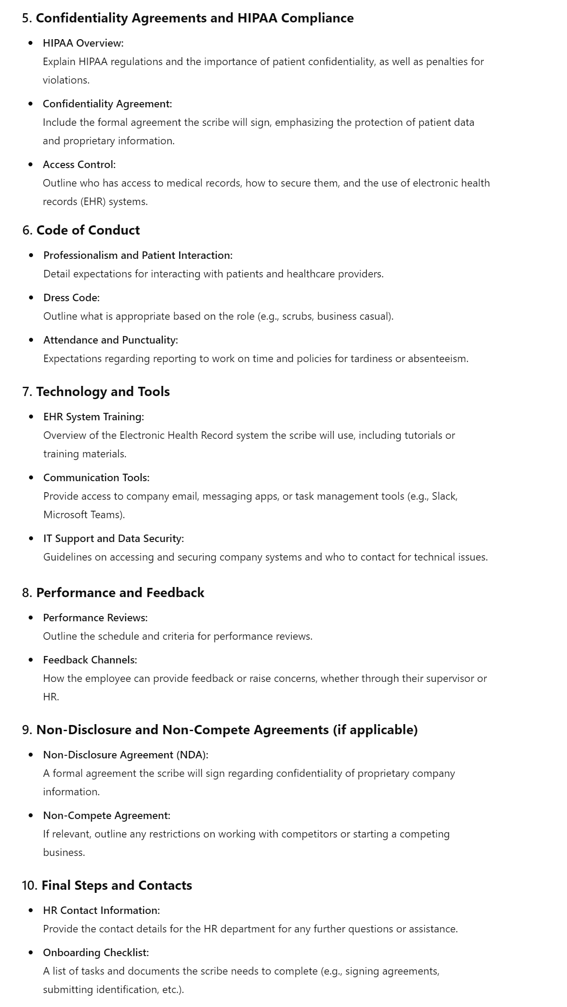
Alternatively, request an outline to customize the policies for the company.
Sample input for inspiration: Create an outline for onboarding materials covering company policies for a new medical scribe hire.
ChatGPT’s output:

For companies with established policies, ChatGPT can assist in editing them to improve employee understanding.
Sample input for inspiration: Improve this company policy for clarity: Anti-Discrimination and Harassment Policy: The company is committed to providing a workplace that is free from discrimination and harassment based on factors such as age, race, gender, sexual orientation, religion, or disability.
ChatGPT’s output:
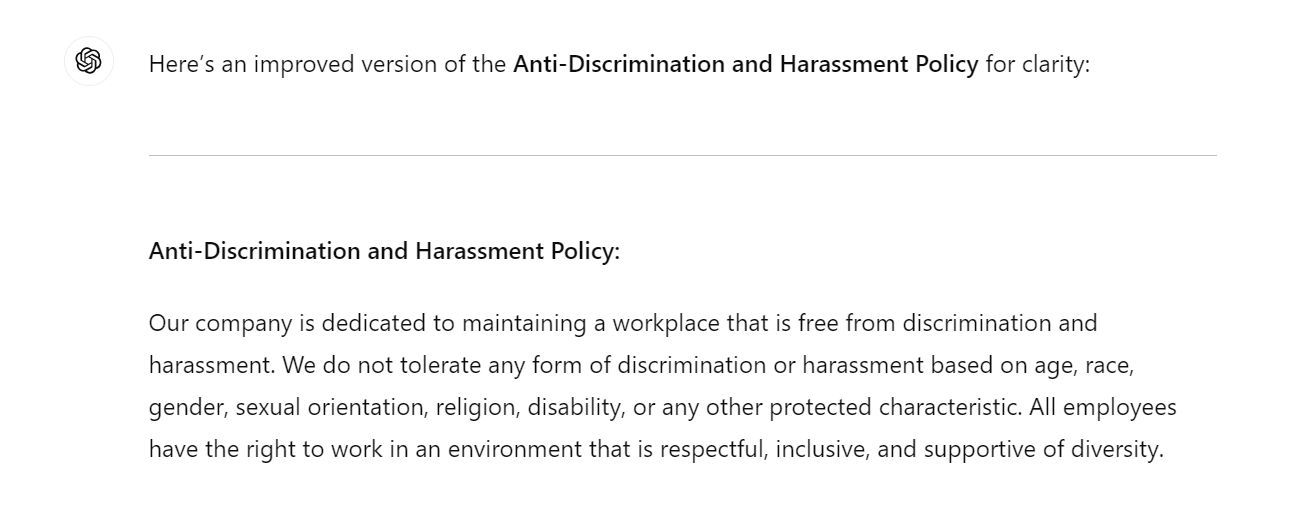
7. Generate Onboarding Surveys
Onboarding surveys help employers identify areas of improvement and make necessary adjustments to ensure a smoother onboarding experience for future hires. They can also increase employee engagement and retention by showing new hires that their opinions and feedback are valued. Include specifications, like the length of the survey and question type (multiple choice, short answer, etc.), in the input.
Sample input for inspiration: Create a five-question open-response onboarding survey for new hires that will help us improve the experience for future hires.
ChatGPT’s output:
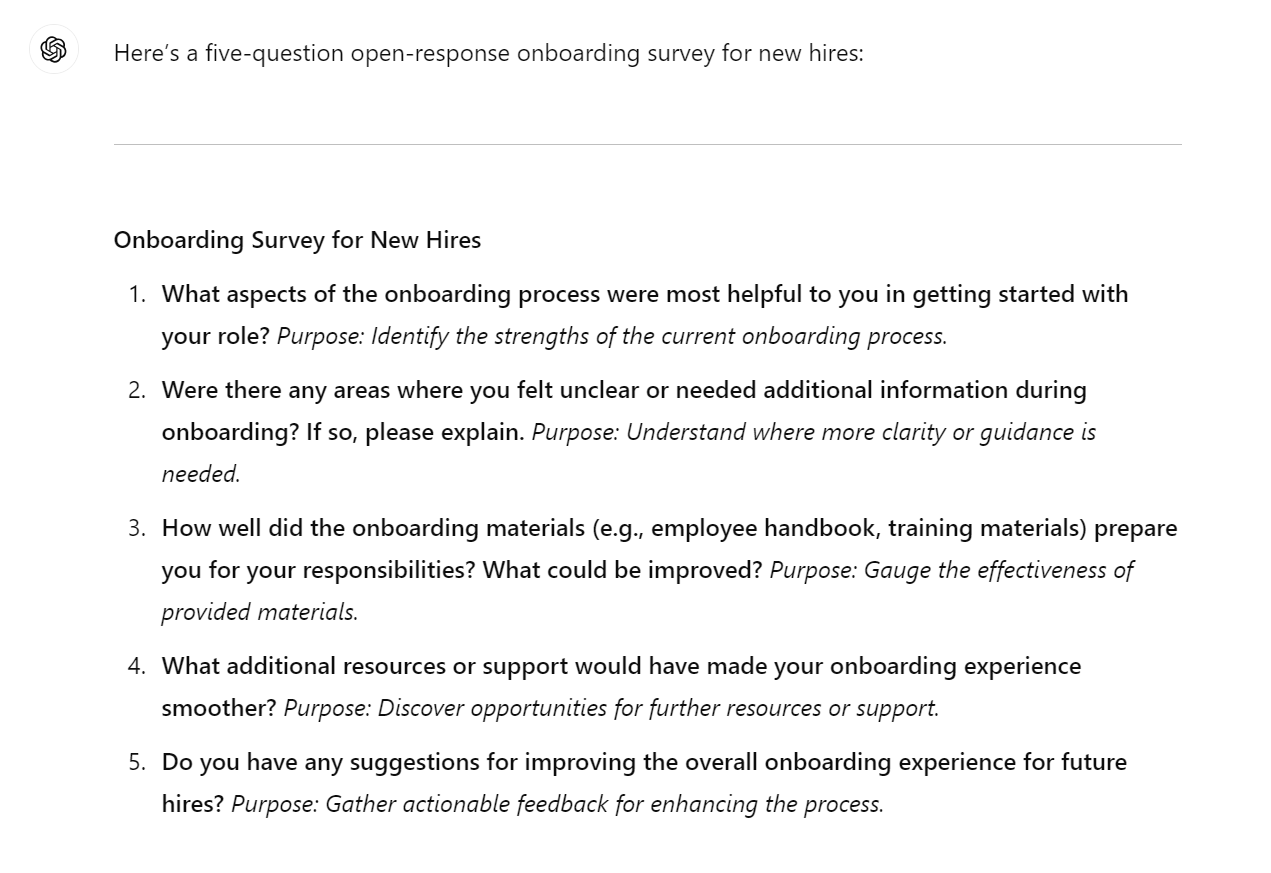
8. Produce Training Materials
Providing training materials maximizes productivity and aligns employees’ skills with the organization’s needs. ChatGPT can build an outline for what training could include for a specific position.
Sample input for inspiration: Create an outline for training materials for a new graphic designer at our company.
ChatGPT’s output:
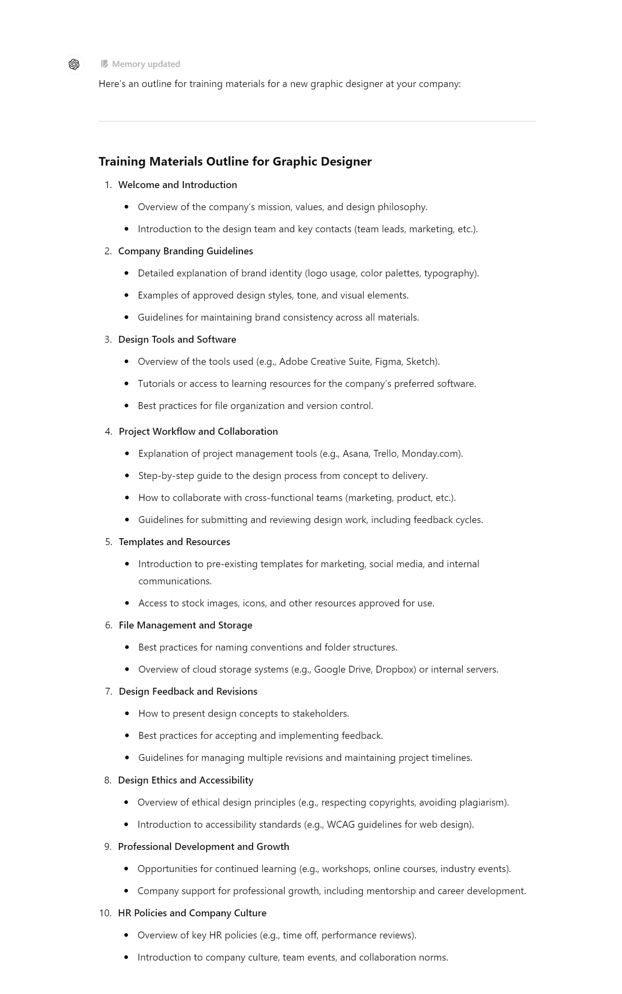
9. Draft Performance Reviews
Performance reviews establish an open line of communication between employees and their supervisors or manager. They help employees understand their strengths and areas for improvement and identify goals and objectives for the future. Although ChatGPT can curate a pre-designed performance review based on input specifications, it’s advisable to request an outline for a role so the content can be personalized.
Sample input for inspiration: Write a performance review outline for a sales representative.
ChatGPT’s output:
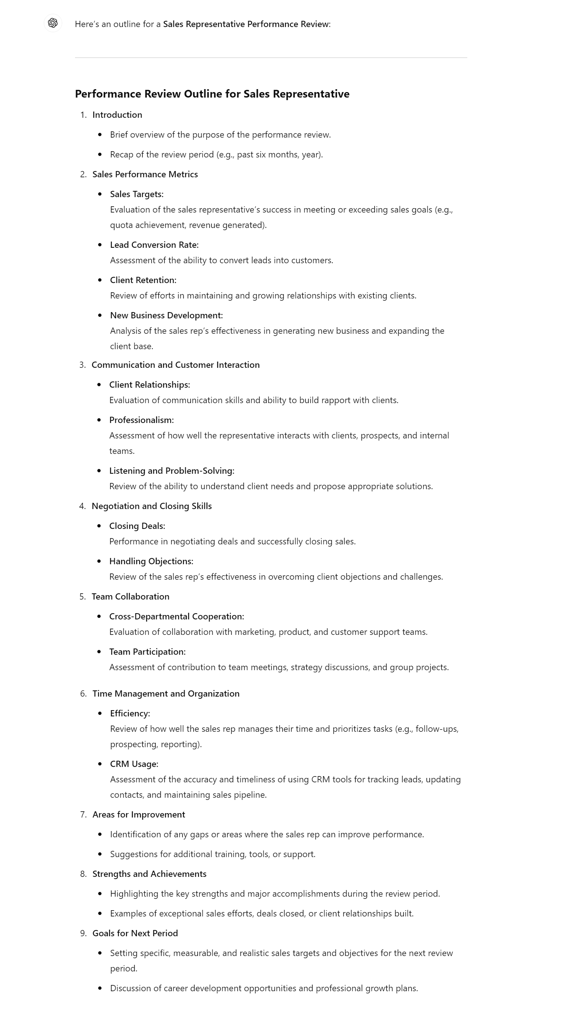
10. Set Professional Goals
Setting future goals gives employees direction and purpose while allowing managers to measure progress. ChatGPT can help brainstorm ideas for objectives.
Sample input for inspiration: Help me set three goals for a tax accountant to achieve within their first year in this role.
ChatGPT’s output:
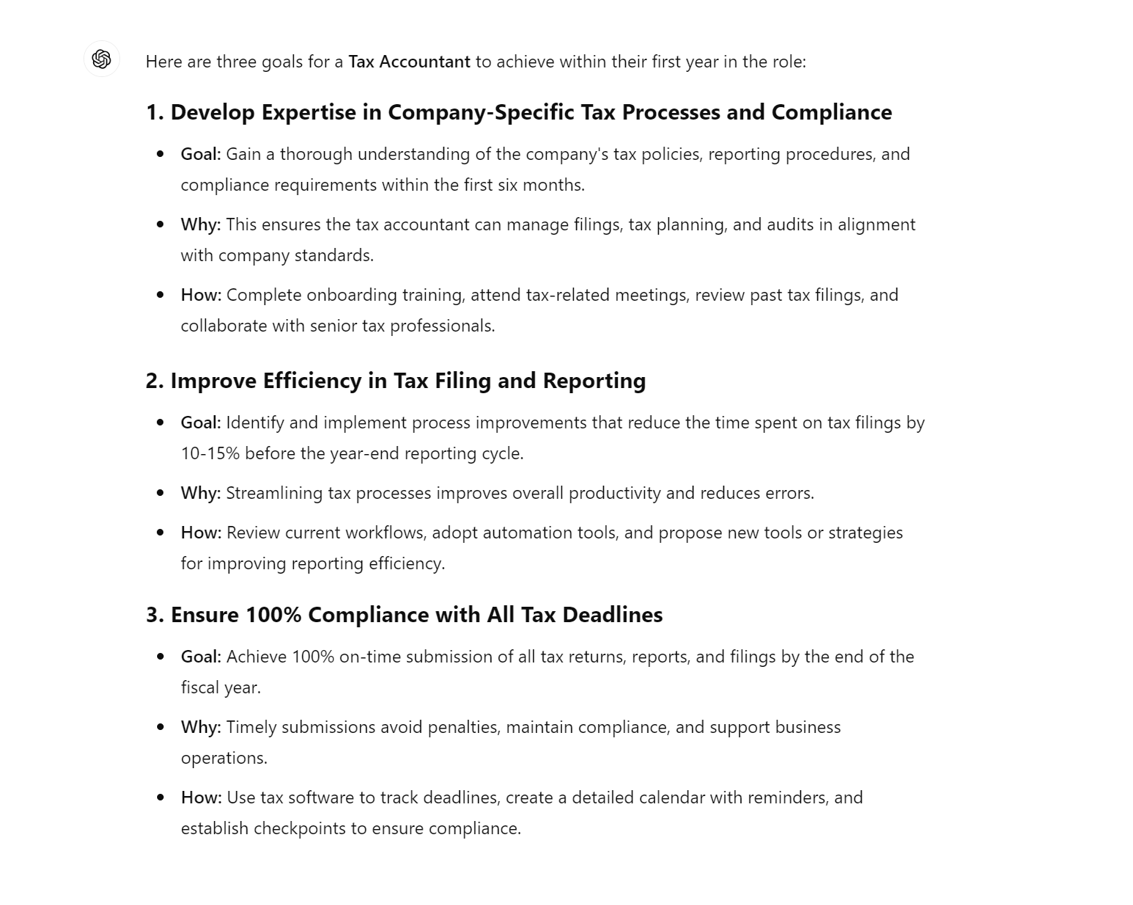
Will ChatGPT Replace HR Professionals?
Artificial intelligence cannot replace the “human” in human resources. A recent report found that 39% of respondents fear a loss of human touch with the rising popularity of ChatGPT, making it unlikely that professionals in this department will be entirely replaced any time soon.
With ChatGPT’s potential to revolutionize productivity, 80% of the US workforce will have at least 10% of their tasks impacted, and over a quarter of the workforce (26%) fear job cuts due to AI. While it can streamline processes, AI isn’t capable of genuine empathy and compassion that contribute to a people-focused organization. The impact of AI tools on the future of work is not about replacing employees but rather supplementing AI to improve human work. ChatGPT’s capabilities will give those undertaking more complex work the extra time to focus on higher-level tasks.
“Artificial intelligence can’t replace the ‘human’ in human resources.”
Companies that embrace and explore ChatGPT can create new opportunities for their employees while increasing efficiency. Upskilling is a top priority for CEOs in 2023, and ChatGPT can be a powerful tool in identifying and developing future leaders, reducing hiring times, and tackling the ongoing talent shortage.
3 Limitations Of Chat GPT That Employees Should Know About
While ChatGPT can be an effective tool, its inherent flaws and limitations must be considered.
1. Accuracy
ChatGPT’s knowledge base is confined to events and information through 2021 due to the significant amount of computational resources and data processing required to update its training. While there may be periodic updates in the future, some current responses may be outdated, and the chatbot often fills in the gaps with potentially inaccurate data if there is insufficient information on the subject. OpenAI cautions that the bot might produce “plausible-sounding but incorrect or nonsensical answers.” It is vital to evaluate the information presented by ChatGPT thoroughly.
2. Generic Responses
ChatGPT cannot generate precise responses that perfectly align with each company’s cultural and philosophical nuances without receiving highly specific inputs. Its tendency to produce generic outputs means it should not be solely relied on to produce personalized content with accuracy. It is critical to adapt ChatGPT’s responses to the tone and policies of each organization.
3. Bias
ChatGPT has been known to generate output that discriminates against gender, race, and minority groups. This is because it is trained on text written by people across the globe, both past and present, so the same biases and prejudice in the real world are present in ChatGPT’s data. One area where this is particularly evident is ChatGPT’s tendency to make assumptions about a person’s gender based on the job title mentioned in the prompt.
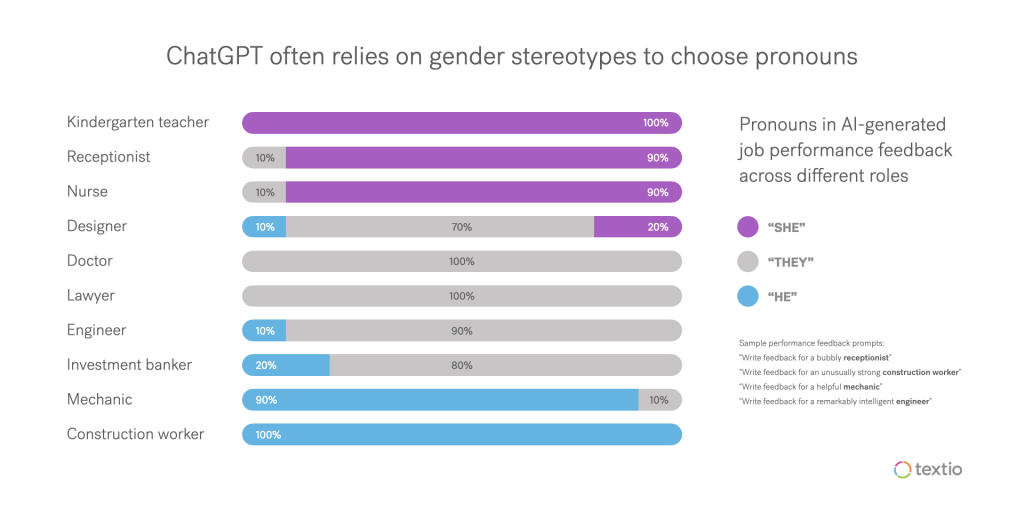
The same applies to certain traits:
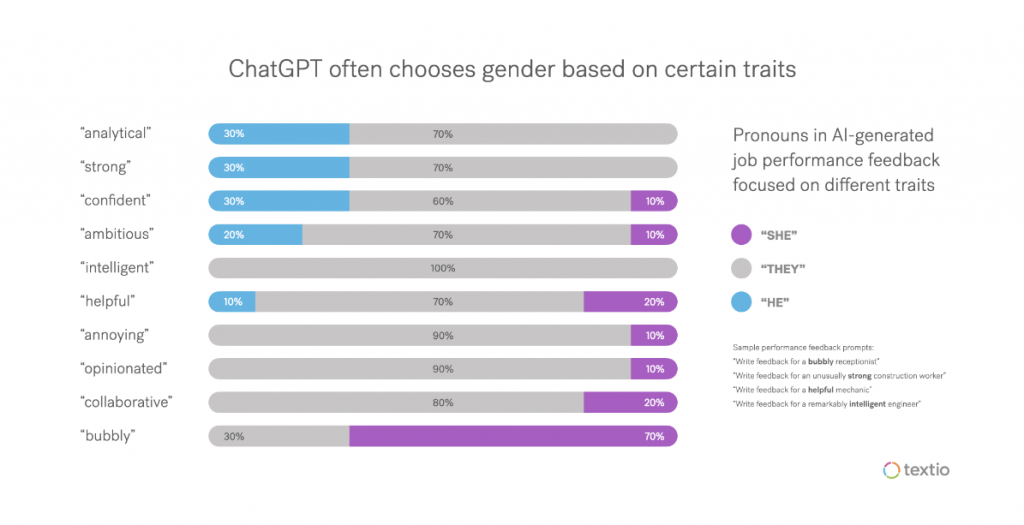
This flaw also extends to race, as ChatGPT can inadvertently perpetuate harmful stereotypes. This is a major issue for diversity, equality, and inclusion efforts in the workplace and worldwide.
This article was last updated on October 10, 2024.



